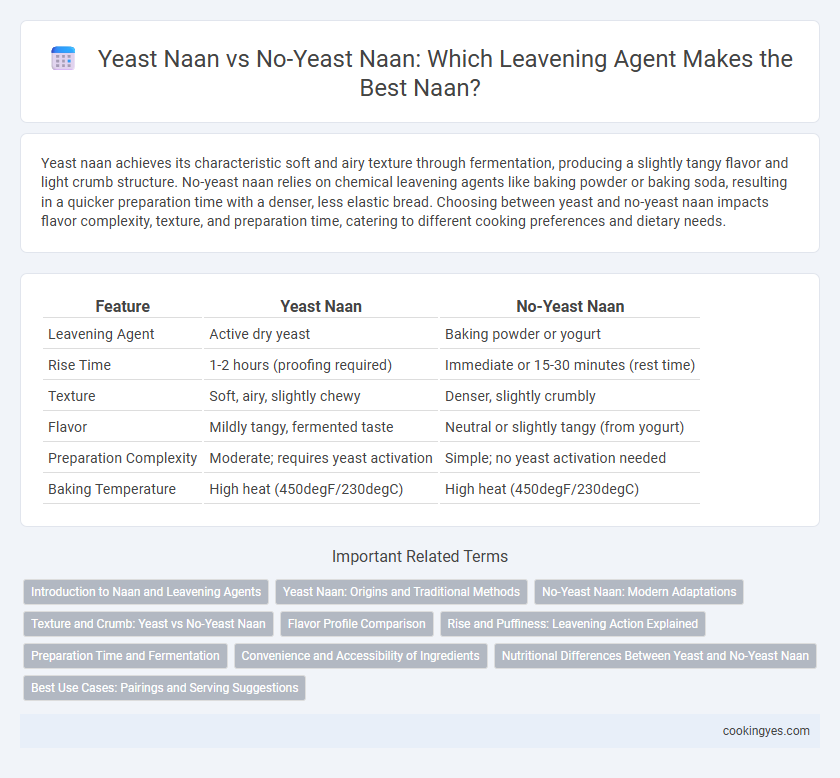Yeast naan achieves its characteristic soft and airy texture through fermentation, producing a slightly tangy flavor and light crumb structure. No-yeast naan relies on chemical leavening agents like baking powder or baking soda, resulting in a quicker preparation time with a denser, less elastic bread. Choosing between yeast and no-yeast naan impacts flavor complexity, texture, and preparation time, catering to different cooking preferences and dietary needs.
Table of Comparison
| Feature | Yeast Naan | No-Yeast Naan |
|---|---|---|
| Leavening Agent | Active dry yeast | Baking powder or yogurt |
| Rise Time | 1-2 hours (proofing required) | Immediate or 15-30 minutes (rest time) |
| Texture | Soft, airy, slightly chewy | Denser, slightly crumbly |
| Flavor | Mildly tangy, fermented taste | Neutral or slightly tangy (from yogurt) |
| Preparation Complexity | Moderate; requires yeast activation | Simple; no yeast activation needed |
| Baking Temperature | High heat (450degF/230degC) | High heat (450degF/230degC) |
Introduction to Naan and Leavening Agents
Naan is a traditional Indian flatbread known for its soft texture and slightly chewy crumb, achieved through effective leavening agents. Yeast naan utilizes active yeast as the primary leavening agent, producing a light, airy texture through fermentation and carbon dioxide release. No-yeast naan relies on chemical leaveners like baking powder or baking soda, creating a quicker rise and denser texture without the fermentation process.
Yeast Naan: Origins and Traditional Methods
Yeast naan originates from South Asian culinary traditions where fermented dough using yeast creates a soft, airy texture with characteristic bubbles and slight tanginess. Traditional methods involve mixing yeast with warm water and flour, allowing the dough to rise over several hours before tandoor baking, which imparts a smoky flavor and distinctive charred spots. This fermentation process not only enhances the naan's leavening but also improves digestibility and flavor complexity compared to no-yeast versions.
No-Yeast Naan: Modern Adaptations
No-yeast naan offers a modern adaptation by using baking powder or baking soda as leavening agents, resulting in a quicker and more convenient preparation compared to traditional yeast naan. This method produces a soft, slightly dense texture while maintaining the characteristic chewiness of naan bread. No-yeast naan is ideal for those seeking fast home baking without lengthy fermentation times, appealing to contemporary culinary preferences.
Texture and Crumb: Yeast vs No-Yeast Naan
Yeast naan features a soft, airy texture with open crumb pockets due to yeast fermentation, providing a distinctive chew and slight tang. No-yeast naan has a denser, more uniform crumb and a chewy texture because it relies on baking powder or yogurt for leavening instead of fermentation. Yeast naan's extended rising time enhances flavor complexity and fluffiness, whereas no-yeast naan offers quicker preparation with a more restrained, chewy bite.
Flavor Profile Comparison
Yeast naan offers a rich, complex flavor with subtle tangy notes due to fermentation, enhancing its softness and chewiness. No-yeast naan tends to have a more neutral, milder taste with a denser texture since it relies on baking powder or baking soda as leavening agents. The distinct fermentation aromas in yeast naan contribute to a more traditional and aromatic flavor profile compared to the straightforward, slightly crisp nature of no-yeast varieties.
Rise and Puffiness: Leavening Action Explained
Yeast naan undergoes fermentation, producing carbon dioxide that creates a pronounced rise and characteristic airy puffiness in the dough. No-yeast naan relies on baking powder or baking soda, which generate a quicker, less intense leavening reaction, resulting in a denser texture with minimal rise. The choice of leavening agent directly influences naan's softness, lightness, and ability to develop distinctive air pockets.
Preparation Time and Fermentation
Yeast naan requires a fermentation period ranging from 1 to 2 hours, allowing the dough to rise and develop a soft, airy texture. No-yeast naan utilizes baking powder or baking soda as chemical leavening agents, enabling immediate preparation with minimal resting time. The fermentation process in yeast naan enhances flavor complexity, while no-yeast naan prioritizes speed and simplicity in preparation.
Convenience and Accessibility of Ingredients
Yeast naan requires active yeast as the leavening agent, which may need proofing time and specific storage conditions, making it less convenient for quick preparation. No-yeast naan utilizes baking powder or baking soda, which are more accessible and allow for faster dough rising without special handling. This makes no-yeast naan a practical choice for home cooks seeking ease and ingredient availability.
Nutritional Differences Between Yeast and No-Yeast Naan
Yeast naan typically contains live yeast, which contributes to fermentation, enhancing digestibility and producing B vitamins like folate during the leavening process. No-yeast naan relies on baking powder or baking soda, resulting in quicker preparation but fewer fermentation-derived nutrients and potentially a higher glycemic index. Nutritionally, yeast naan may offer slight benefits in terms of probiotics and micronutrient content compared to no-yeast naan, which lacks microbial fermentation effects.
Best Use Cases: Pairings and Serving Suggestions
Yeast naan offers a soft, airy texture ideal for rich, spicy curries like butter chicken or lamb rogan josh, enhancing the dish's depth of flavor. No-yeast naan is denser and quicker to prepare, making it perfect for casual meals or street food-style dishes such as tandoori chicken wraps or vegetable pakoras. Pair yeast naan with robust sauces to complement its fluffiness, while no-yeast naan works well with dry or mildly spiced accompaniments for a balanced bite.
Yeast Naan vs No-yeast Naan for Leavening Agent Infographic

 cookingyes.com
cookingyes.com